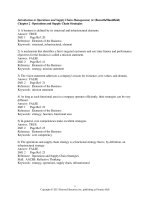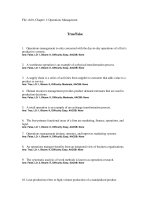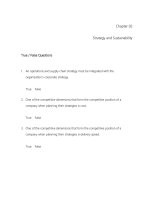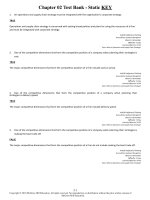Introduction to operations and supply chain management 3e bozarth chapter 06
Bạn đang xem bản rút gọn của tài liệu. Xem và tải ngay bản đầy đủ của tài liệu tại đây (572.9 KB, 44 trang )
Managing Capacity
Chapter 6
Chapter Objectives
Be able to:
Explain what capacity is, how firms measure capacity, and the
difference between theoretical and rated capacity.
Describe the pros and cons associated with three different
capacity strategies: lead, lag, and match.
Apply a wide variety of analytical tools to capacity decisions,
including expected value and break-even analysis, decision
trees, learning curves, the Theory of Constraints, waiting line
theory, and Little’s Law.
Copyright © 2013 Pearson Education, Inc. publishing as Prentice Hall
6-2
Definitions
Capacity – The capability of a worker, a machine, a
workcenter, a plant, or an organization to produce
output in a time period.
Capacity decisions
–
© 2010 APICS Dictionary
How is it measured?
Which factors affect capacity?
The impact of the supply chain on the organization’s
effective capacity.
Copyright © 2013 Pearson Education, Inc. publishing as Prentice Hall
6-3
Measures of Capacity
Theoretical capacity – The maximum output
capability, allowing for no adjustments for
preventive maintenance, unplanned downtime, or
the like.
Rated capacity – The long-term, expected output
capability of a resource or system.
© 2010 APICS Dictionary
Copyright © 2013 Pearson Education, Inc. publishing as Prentice Hall
6-4
Examples of Capacity
Table 6.1
Copyright © 2013 Pearson Education, Inc. publishing as Prentice Hall
6-5
Indifference Point Examples
Capacity for a PC Assembly Plant
(800 units per line per shift)×(# of lines)×(# of shifts)
Controllable Factors
Uncontrollable Factors
1 or 2 shifts?
2 or 3 lines? Employee
training?
Supplier problems?
98% or 100% good?
Late or on time?
Copyright © 2013 Pearson Education, Inc. publishing as Prentice Hall
6-6
Three Common
Capacity Strategies
Lead capacity strategy – A capacity strategy in which
capacity is added in anticipation of demand.
Lag capacity strategy – A capacity strategy in which
capacity is added only after demand has
materialized.
Match capacity strategy – A capacity strategy that
strikes a balance between the lead and lag capacity
strategies by avoiding period of high under or
overutilization.
Copyright © 2013 Pearson Education, Inc. publishing as Prentice Hall
6-7
Comparing Strategies
Figure 6.1
Copyright © 2013 Pearson Education, Inc. publishing as Prentice Hall
6-8
Evaluating Capacity Alternatives
Cost Comparison
Expected Value
Decision Trees
Break-Even Analysis
Learning Curves
Copyright © 2013 Pearson Education, Inc. publishing as Prentice Hall
6-9
Cost Comparison
Fixed costs – The expenses an organization incurs
regardless of the level of business activity.
Variable costs – Expenses directly tied to the level of
business activity.
Copyright © 2013 Pearson Education, Inc. publishing as Prentice Hall
6 - 10
Cost Comparison
TC = FC + VC * X
TC = Total Cost
FC = Fixed Cost
VC = Variable cost per unit of business activity
X = amount of business activity
Copyright © 2013 Pearson Education, Inc. publishing as Prentice Hall
6 - 11
Cost Comparison - Example 6.1
Table 6.2
Figure 6.2
Copyright © 2013 Pearson Education, Inc. publishing as Prentice Hall
6 - 12
Cost Comparison - Example 6.1
Total cost of common carrier option = Total cost of contract carrier option
$0 + $750X = $5,000 + $300X
X = 11.11 or 11 shipments
Find the indifference point – the output level at which
the two alternatives generate equal costs.
Total cost of contract carrier option = Total cost of leasing
$5,000 + $300X = $21,000 + $50X
X = 64 shipments
Copyright © 2013 Pearson Education, Inc. publishing as Prentice Hall
6 - 13
Expected Value
Expected value – A calculation that summarizes the
expected costs, revenues, or profits of a capacity
alternative, based on several demand levels with
different probabilities.
Copyright © 2013 Pearson Education, Inc. publishing as Prentice Hall
6 - 14
Expected Value – Example 6.2
Copyright © 2013 Pearson Education, Inc. publishing as Prentice Hall
6 - 15
Expected Value – Example 6.2
C(low demand) = $5,000 + $300(30) = $14,000
C(medium demand) = $5,000 + $300(50) = $20,000
C(high demand) = $5,000 + $300(80) = $29,000
EVContract = (14,000 * 25%) + ($20,000 * 60%) + ($29,000 * 15%)
= $19,850
EVCommon = (22,500 * 25%) + ($37,500 * 60%) + ($60,000 * 15%)
= $37,125
EVLease = (22,500 * 25%) + ($23,500 * 60%) + ($25,000 * 15%)
= $23,475
Copyright © 2013 Pearson Education, Inc. publishing as Prentice Hall
6 - 16
Decision Trees
Decision tree – A visual tool that decision makers
use to evaluate capacity decisions to enable users to
see the interrelationships between decisions and
possible outcomes.
Copyright © 2013 Pearson Education, Inc. publishing as Prentice Hall
6 - 17
Decision Tree Rules
Draw the tree from left to right starting with a
decision point or an outcome point and develop
branches from there.
Represent decision points with squares.
Represent outcome points with circles.
For expected value problems, calculate the financial
results for each of the smaller branches and move
backward by calculating weighted averages for the
branches based on their probabilities.
Copyright © 2013 Pearson Education, Inc. publishing as Prentice Hall
6 - 18
Decision Trees – Example 6.3
Original Expected
Value Example
Figure 6.4
Copyright © 2013 Pearson Education, Inc. publishing as Prentice Hall
6 - 19
Break-Even Analysis
Break-even point – The volume level for a business
at which total revenues cover total costs.
Where:
BEP = break-even point
FC = fixed costs
VC = variable cost per unit of business activity
R = revenue per unit of business activity
Copyright © 2013 Pearson Education, Inc. publishing as Prentice Hall
6 - 20
Break-Even Analysis – Example 6.4
Suppose the firm makes $1,000 profit on each shipment
before transportation costs are considered. What is the
break-even point for each shipping option?
Contracting: BEP = $5,000 / $700 = 7.1 or 8 shipments
Common: BEP = $0 / $250 = 0 shipments
Leasing: BEP = $21,000 / $950 = 22.1 or 23 shipments
Copyright © 2013 Pearson Education, Inc. publishing as Prentice Hall
6 - 21
Learning Curves
Learning curve theory – A theory that suggests that
productivity levels can improve at a predictable rate
as people and even systems “learn” to do tasks
more efficiently.
For every doubling of cumulative output, there
is a set percentage reduction in the amount
of inputs required.
Copyright © 2013 Pearson Education, Inc. publishing as Prentice Hall
6 - 22
Learning Curves
Copyright © 2013 Pearson Education, Inc. publishing as Prentice Hall
6 - 23
Learning Curve – Example 6.5
What is the learning percentage?
4/5 = 80% or .80
Copyright © 2013 Pearson Education, Inc. publishing as Prentice Hall
6 - 24
Learning Curve – Example 6.5
How long will it take to answer the 25th call?
Figure 6.6
Copyright © 2013 Pearson Education, Inc. publishing as Prentice Hall
6 - 25









